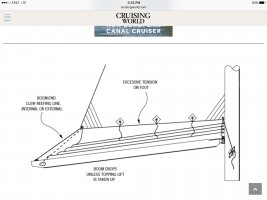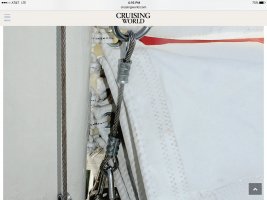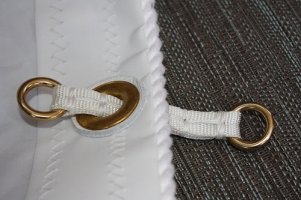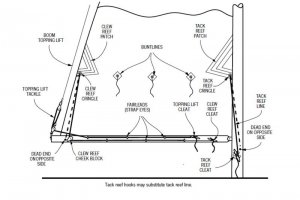I spent quite a bit of time sailing so far this summer on Cinderella, and while my rig is a bit different, the process is nearly the same. From what I have read, overlapping sails eventually produce more heel than forward drive, In light winds, you want a bit of heel to use gravity to keep the sails open and utilize even the smallest puffs of air, an overlapping sail is nice here. It will also help increase the waterline length as the wind builds and allow for a faster theoretical hull speed. I believe Ericsons were designed to be great light wind boats for southern California, that translates to tenderness as the wind builds (that whole compromise thing).
The following I have found to be true while sailing to windward, it is all we seem to do here in the Puget Sound. In general, more sail can be carried downwind as the apparent wind on the sail is going to be about 6kts or so less.
After the wind exceeds about 12kts I have found that going to a smaller headsail will actually keep the boat moving faster and heeled less.
You can also play with traveling up the main and sheeting it to the centerline of the boat. This will in effect stall the front of the main and work the back of the sail keeping the boat flatter. Make sure to use the vang to keep the aft edge of the sail presented properly to the wind. Many of the J boats do this as their boats don't do as well heeled as ours.
If you have a cunningham our outhaul, this is an excellent tool for reducing draft in your main and reducing heel as well.
If you have a backstay tensioner, you can also tension the backstay to flatten the top of the main and reduce the draft and therefore heel. You will also be tightening up the jibstay and moving Jib draft forward also helping reduce heel.
As the wind builds rolling in the jib or changing it is the best course of action to reduce heel. Excessive draft in the main will also give the same effect and lead to weather helm (boat trying to pull you into the wind). The mainsail will allow the boat to point higher than the jib, so going to windward, you will want it flying in some regard (reefed or not) to keep the boat driving. The trick is matching the sail area from both sails.
In general, this is what I look for on our E-35 Cinderella.
0-12 kts full sails, main & number 1 jib about 150%. As the wind nears the 12 mark, if I'm close hauled I will tighten the cunningham to suck in some draft from the main to keep her more upright.
12-18ish kts headsail change #3 or about 100% jib, hopefully one day I will have the furler installed and this will consist of rolling in some jib. Again as the wind builds pull in on the cunningham to reduce main draft and keep the boat more upright and adding backstay tension to keep draft in correct location in mainsail and jib.
18-25ish kts reef #1 in main still flying 100% jib
25-30ish kts reef #2 in main still flying 100% jib.
30-40ish kts drop 100% jib and go to storm jib and 2 reefs in the main if sailing to windward probably wishing I had a 3rd reef, if running probably time to drop the main. The seas here in the sound would be about 10-12ft and accidental jibes are no fun.
40-? kts not sure, haven't sailed in it. I imagine if downwind sailing this is the time to drop all main and fly under storm jib alone. If the boat is going to fast, time to throw things off the stern tied to a line. If the plan is to sail upwind a third reef would be nice to keep the keel building lift and the boat driving forward. Since I don't have a third reef, I would probably be putting up my trisail then going below to change my baselayer...
*Disclaimer*
I have never taken any sailing classes. I am self taught mostly from books and sailing. I do get on a few raceboats here and there and observe what the skippers will do, but the vast majority of my sailing in big wind is aboard Cinderella. I was fortunate to have a fun crew that was willing to push the boat and race Swiftsure this year, during the delivery we saw what we later found out was 40kts from US border patrol (our anemometer began to stall at about 35kts). I am happy to say that we were still making 5-6kts close hauled in that breeze. It is a testament to the design of the E boats. There is no way I could have gotten my old Newport to do anything like that.
-P




